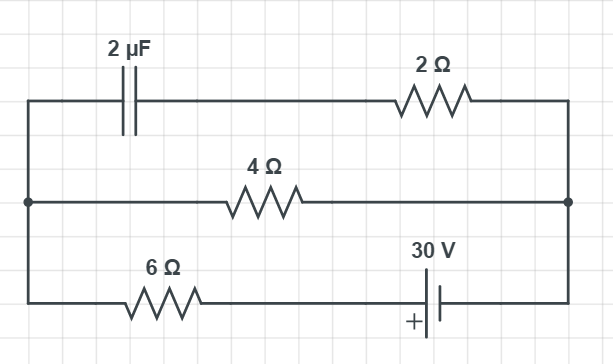
Find the charge stored in the capacitor

A) $24\,\mu C$
B) $12\,\mu C$
C) $16\,\mu C$
D) $20\,\mu C$

Answer
539.4k+ views
Hint: In this type of questions, it’s better to first understand the circuit properly and then find the information that is not mentioned in the question, such as current, potential difference and voltage across the resistors. After all the information is calculated, then using the formula for calculating charge, we can get the charge stored in the capacitor.
Formula used:
$V=IR$
Complete answer:
In steady state current flows in the lower loop of the circuit only, due to which the resistor of $4\,\Omega \,\text{and}\,6\,\Omega $ are connected in series, so the net resistance is:
$\begin{align}
& {{R}_{Net}}=(6+4)\,\Omega \\
& \therefore {{R}_{Net}}=10\,\Omega \\
\end{align}$
Using Ohm’s Law,
$V=IR$
where,
‘$I$’ is Current,
‘$V$’ is Voltage, and
‘$R$’ is Resistance.
Substituting the value of V and R in the above equation, we get –
$\begin{align}
& 30\,V=I\times 10\,\Omega \\
& \therefore I=3\,A \\
\end{align}$
Since, Potential difference across capacitor is equal to the potential difference across the $4\,\Omega $ resistance, so
$\text{Potential Difference across Capacitor}=IR=(3\,\times \,4)\,V=12\,V$.
Now, the charge stored in the capacitor can be found using the formula,
$q=CV$
where,
‘$q$’ is Charge,
‘$C$’ is Capacitor value, and
‘$V$’ is Potential Difference.
Substituting the given and obtained value in the above equation, we get –
$\begin{align}
& q=(2\,\mu F)(12\,V) \\
& \therefore q=24\,\mu C \\
\end{align}$
Therefore, the correct answer is Option (A).
Note:
Questions related to the circuit diagram are very frequently asked in papers and are easy to solve as well. To solve this type of questions, first understand the circuit diagram properly and make a list of details that are given in the question and also the details that need to be calculated, which will help to break the questions in small parts and solve the question part by part easily.
Formula used:
$V=IR$
Complete answer:
In steady state current flows in the lower loop of the circuit only, due to which the resistor of $4\,\Omega \,\text{and}\,6\,\Omega $ are connected in series, so the net resistance is:
$\begin{align}
& {{R}_{Net}}=(6+4)\,\Omega \\
& \therefore {{R}_{Net}}=10\,\Omega \\
\end{align}$
Using Ohm’s Law,
$V=IR$
where,
‘$I$’ is Current,
‘$V$’ is Voltage, and
‘$R$’ is Resistance.
Substituting the value of V and R in the above equation, we get –
$\begin{align}
& 30\,V=I\times 10\,\Omega \\
& \therefore I=3\,A \\
\end{align}$
Since, Potential difference across capacitor is equal to the potential difference across the $4\,\Omega $ resistance, so
$\text{Potential Difference across Capacitor}=IR=(3\,\times \,4)\,V=12\,V$.
Now, the charge stored in the capacitor can be found using the formula,
$q=CV$
where,
‘$q$’ is Charge,
‘$C$’ is Capacitor value, and
‘$V$’ is Potential Difference.
Substituting the given and obtained value in the above equation, we get –
$\begin{align}
& q=(2\,\mu F)(12\,V) \\
& \therefore q=24\,\mu C \\
\end{align}$
Therefore, the correct answer is Option (A).
Note:
Questions related to the circuit diagram are very frequently asked in papers and are easy to solve as well. To solve this type of questions, first understand the circuit diagram properly and make a list of details that are given in the question and also the details that need to be calculated, which will help to break the questions in small parts and solve the question part by part easily.
Recently Updated Pages
Master Class 12 Business Studies: Engaging Questions & Answers for Success

Master Class 12 Economics: Engaging Questions & Answers for Success

Master Class 12 English: Engaging Questions & Answers for Success

Master Class 12 Maths: Engaging Questions & Answers for Success

Master Class 12 Social Science: Engaging Questions & Answers for Success

Master Class 12 Chemistry: Engaging Questions & Answers for Success

Trending doubts
What is meant by exothermic and endothermic reactions class 11 chemistry CBSE

Which animal has three hearts class 11 biology CBSE

10 examples of friction in our daily life

One Metric ton is equal to kg A 10000 B 1000 C 100 class 11 physics CBSE

1 Quintal is equal to a 110 kg b 10 kg c 100kg d 1000 class 11 physics CBSE

Difference Between Prokaryotic Cells and Eukaryotic Cells




